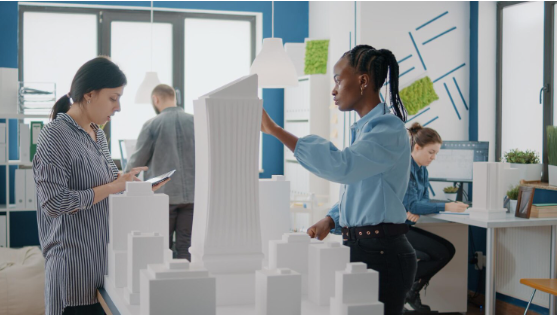Introduction:
In the intricate world of architecture, engineering, and construction, pursuing harmony in design is an eternal symphony. Buildings and infrastructure should be functional and aesthetically pleasing, and to orchestrate this blend, there’s an innovative conductor in town: Building Information Modeling (BIM). This article is your backstage pass to the BIM concert, where we explore how BIM techniques have become the key to achieving harmony in design by unveiling clash detection and resolution’s hidden potential.
I. What is Building Information Modeling (BIM)?
Imagine a digital twin of a building or infrastructure project, complete with its every detail, evolving and maturing alongside the actual construction. That’s BIM – a holistic digital representation that includes geometry, spatial relationships, geographic information, quantities, and properties of components.
BIM is not just a tool; it’s a revolution. We’ll trace its evolution from 2D blueprints to the three-dimensional digital wonder it is today.
BIM is no mere spectator; it’s a star player. We’ll examine how it transforms the design and construction game.
II. Clash Detection in Design: The Traditional Challenges
Think of traditional design as a puzzle with missing pieces. We used to put it all together only to find that some parts didn’t fit. Clash detection was an afterthought, causing delays and cost overruns.
Limitations and drawbacks:
The flaws of the old ways. We explore why they failed to create harmony.
Case examples of issues caused by lack of clash detection:
Horror stories from the field – projects that went awry due to overlooked clashes.
III. The Advent of BIM Clash Detection Techniques
The BIM clash detection process:
Meet the superhero of this tale – BIM’s clash detection. How it works and why it’s so efficient.
Benefits of BIM clash detection:
We’ll unveil the perks – faster problem-solving, reduced rework, and happier stakeholders.
Real-world examples of successful clash detection:
Success stories that’ll make you a believer in the power of BIM.
IV. Resolution Strategies: From Clash to Harmony
Identifying clashes efficiently:
We discuss how BIM doesn’t just point out clashes but also simplifies the process of solving them.
Collaborative problem-solving with BIM:
Imagine architects, engineers, and contractors sitting around a digital table, working together to achieve harmony – BIM makes it happen.
Streamlining communication among project stakeholders:
The key to harmony is communication. BIM ensures everyone is on the same page.
V. Visualizing Harmony: The Impact on Design and Construction
How BIM techniques influence design:
See how BIM redefines the creative process – enhancing both aesthetics and functionality.
Streamlining construction processes:
BIM doesn’t just make designs beautiful; it makes construction smoother.
Realizing cost savings and efficiency:
A harmonious design process saves time and money – a win-win for everyone.
VI. Case Studies: BIM in Action
Case 1: High-rise building construction:
How BIM conquers the skies and ensures tall structures stand tall and harmonious.
Case 2: Infrastructure projects (bridges, highways):
Bridges that bridge gaps and highways that lead to unity – all thanks to BIM.
Case 3: Complex interiors (e.g., hospitals, airports):
The complexity of interiors is different for BIM’s prowess.
VII. Challenges and Future Directions
Ongoing challenges in BIM clash detection:
Perfection is an aspiration, not a reality. We explore the challenges BIM still faces.
Future innovations and trends:
What’s next for BIM? A peek into the crystal ball.
VIII. Conclusion: Crafting Harmonious Infrastructure through BIM
Recap of the key takeaways:
A final note summarizing the journey from clashes to harmony.
The role of BIM in achieving design harmony:
BIM is the maestro, guiding the orchestra to design harmony.
Encouraging widespread adoption of BIM techniques:
Why we should all embrace the BIM revolution for a harmonious future.
Closing Thoughts:
In a world where design harmony is the ultimate aspiration, BIM is the conductor that ensures all the instruments are in tune. By mastering clash detection and resolution, BIM is creating a symphony in design that is both beautiful and efficient, saving both time and resources. As we continue to face new challenges and explore future innovations, BIM is set to remain the virtuoso of the architecture, engineering, and construction world, harmonizing our built environment for generations to come.
 seolounge
seolounge